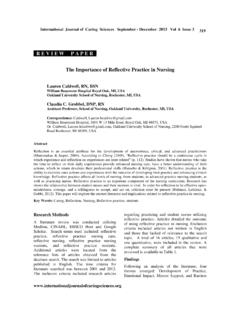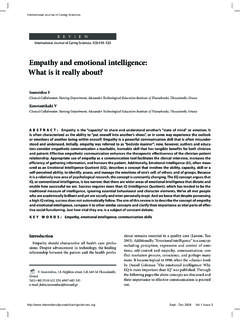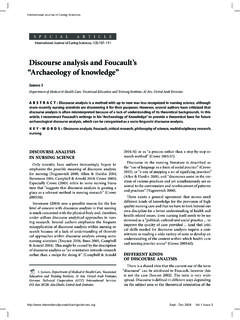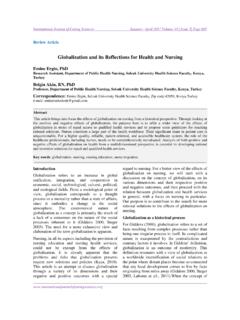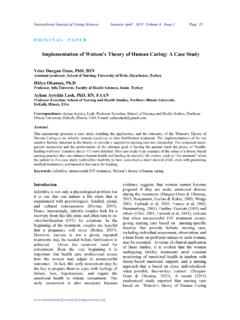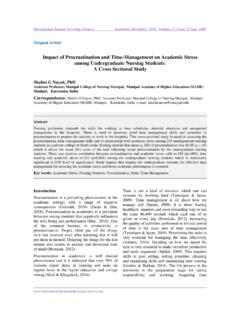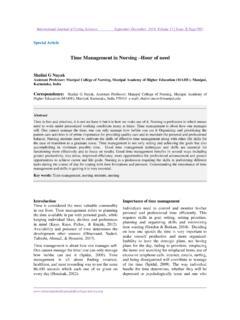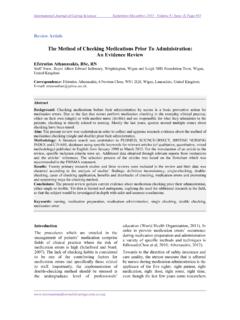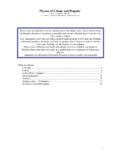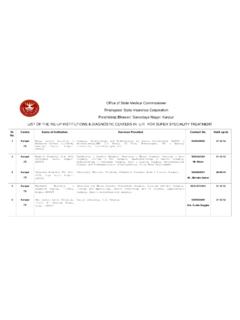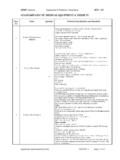Transcription of Invasive and non-invasive methods for cardiac output ...
1 REVIEWI nternational Journal of Caring Sciences, 1(3):112 117 Invasive and non- Invasive methods for cardiac output measurementLavdaniti MClinical Professor, Department of Nursing, Alexander Technological Educational Institute of Thessaloniki, GreeceABSTRACT:The hemodynamic status monitoring of high-risk surgical patients and critically ill patients in Intensive Care Units is one of the main objectives of their therapeutic management. cardiac output is one of the most important parameters for cardiac function monitoring, providing an estimate of whole body perfusion oxygen deliv-ery and allowing for an understanding of the causes of high blood pressure. The purpose of the present review is the description of cardiac output measurement methods as presented in the international literature. The articles document that there are many methods of monitoring the hemodynamic status of patients, both Invasive and non- Invasive , the most popular of which is thermodilution.
2 The Invasive methods are the Fick method and thermodilution, whereas the non- Invasive methods are oeshophaegeal doppler , transoesophageal echocardiography, lithium dilution, pulse contour, partial CO2 rebreathing and thoracic electrical bioimpedance. All of them have their advantages and disad-vantages, but thermodilution is the golden standard for critical patients, although it does entail many risks. The ideal system for cardiac output monitoring would be non- Invasive , easy to use, reliable and compatible in patients. A number of research studies have been carried out in clinical care settings, by nurses as well as other health professionals, for the purpose of finding a method of measurement that would have the least disadvantages. Nevertheless, the thermodilu-tion technique remains the most common approach in use : cardiac output , thermodilution, Fick method, doppler monitor, bioimpendance, critically ill patients~ M.
3 Lavdaniti, Nursing Department, Alexander Technological Education Institute of Thessaloniki, Thessaloniki, GreecePO Box 1456, GR-541 01, Thessaloniki, GreeceTel: +30 2310-791503, +30 6937-865 660e-mail: The hemodynamic status monitoring of high-risk sur-gical patients and critically ill patients in Intensive Care Units is one of the main objectives of their therapeutic management (Hett & Jonas 2003). cardiac output is one of the most important parameters for cardiac fun-ction monitoring, providing an estimate of whole body perfusion oxygen delivery and allowing for an under-standing of the causes of high blood pressure (Berton & Cholley 2002). cardiac ouput is the volume of blood pumped by the heart per minute and is the product of the heart rate and stroke volume. The stroke volume of the ventricle is de-termined by the interactions between its preload, con-tractility and afterload (Prabhu 2007, Guyton 1991).
4 Over the past decades, many methods for cardiac out-put measurement have been developed. The most widely widespread is the Invasive method of thermodilution, which, however, involves the danger of inserting a Swan-International Journal of Caring Sept - Dec 2008 Vol 1 Issue 3 Invasive AND NON- Invasive methods FOR MEASUREMENT OF cardiac output 113 Ganz catheter into the circulatory system. Many alterna-tive methods , both Invasive and non- Invasive , have been used, but even today, clinical observation is the most important for the clinical decision-making process. In clinical care settings, many extensive research studies are in progress for the purpose of finding a method for cardiac output measurement having as few disadvantag-es as ideal system for cardiac output monitoring would be non- Invasive , easy to use, accurate, reliable, consist-ent and compatible in patients (Mathews & Singh 2008, Yakimets & Jensen 1995).
5 At present, no single technique meets all these criteria (Mathews & Singh 2008).The purpose of the present review is to describe the cardiac output measurement methods as presented in the international literature. Invasive methods Fick method This method is based on the principle described by Adolfo Fick in 1870, according to which the total up-take or release of a substance by an organ is the product of the blood f low through the organ and the arteriov-enous concentration difference of the substance (Berton & Cholley et al 2002, Prahbu 2007, Mathews & Singh 2008). The oxygen uptake in the lungs is the product of the blood f low through the lungs and the arteriovenous oxygen content difference. Therefore, cardiac output can be calculated using the equation:CO = VO2 CaO2 CvO2 Where VO2 is the oxygen consumption by the lungs and CaO2 CvO2 is the arteriovenous difference in oxy-gen (Berton &Cholley et al 2002, Engoren & Barbee 2005, Mathews & Singh 2008).
6 Oxygen consumption is measured with special devices. The arteriovenous difference is computed by receiving samples of arterial blood, and mixed venous blood by receiving blood from the pulmonary artery (Tibby et al 1997, Bougalt et al 2005, Mathews & Singh 2008). The mixed venous blood is received via a catheter that reach-es up to the right ventricular and the pulmonary artery (Tibby et al 1997, Mathews & Singh 2008). Mathews & Sigh stated that the arteriovenous oxygen content dif-ference can be measured in situ using a pulmonary ar-tery catheter having fibreoptic bundles incorporated in the catheter The Fick method has limitations which are marked in patients with lung abnormalities (Engoren & Barbee 2005); it is costly and may lead to complications (Yung et al 2004). Also, it is considered the most accurate method available to evaluate patients with low cardiac output (Ultman & Burtzstein 1981, Mathews & Sigh 2008).
7 Thermodilution methodThis is an intermittent technique widely accepted in clinical settings (Prahbu 2007). It is a method relying on a principle similar to indicator dilution, but it uses heat rather than colour as an indicator (Mathews & Singh 2008).This method uses a special thermistor tipped cath-eter (Swan-Ganz catheter) inserted from a central vein into the pulmonary artery. A cold solution of D/W 5% or normal saline (temperature 0 oC) is injected into the right atrium from a proximal catheter port. This solu-tion causes a decrease in blood temperature, which is measured by a thermistor placed in the pulmonary ar-tery catheter (Tibby et al 1997, Prahbu 2007). The de-crease in temperature is inversely proportional to the dilution of the injectate (Prahbu 2007). The cardiac out-put can be derived from the modified Stewart-Hamilton conservation of heat equation (Fillipatos & Baltopoulos 1997, Prahbu 2007).
8 The pulmonary artery catheter is at-tached to the cardiac output computer, which displays a curve and calculates output and derived indices auto-matically (Prahbu 2007). Thermodilution technique remain the most common approach in use today and is considered as the golden standard approach to cardiac output monitoring (Hett & Jonas 2003, Prahbu 2007), although it involves many risks, such as pneumothorax, dysrythmias, perforation of the heart chamber, tamponade and valve damage (Hett & Jonas 2003). Also, it is reported that there are some concerns regarding the appropriateness of routine use of pulmonary catheters in critical patients (Albert et al 2004, Connors et al 1996).Factors that may compuromise this technique are shunts, tricuspid regurgitation, cardiac arrythmias, abnormal respiratory patterns and low cardiac output (Prahbu 2007).
9 Some studies have supported concerns regarding the appropriateness of pulmonary artery catheters use in critically ill patients, since catheters are associated with increased morbidity and mortality (Connors et al 1996, Sandham et al 2003).International Journal of Caring Sept - Dec 2008 Vol 1 Issue 3114 M. LAVDANITINon- Invasive cardiac output monitoring Oesophageal doppler The Oesophageal doppler monitor was first described in the early 1970s (Gan & Arrowsmith 1997). This tech-nique measures blood f low velocity in the descend-ing thoracic aorta (Gan & Arrowsmith 1997, Poelaert et al 1999, Hett & Jonas 2003, Mathews & Singh 2008, Working Group 2008) using a f lexible ultrasound probe about the size of a nasogastric tube (Gan & Arrowsmith 1997). This measurement can be combined with an es-timate of the cross-sectional area of the aorta, which is derived from the patient s age, height and weight, and allows hemodynamic variables including stroke volume, cardiac output and cardiac index to be calculated (Gan & Arrowsmith 1997, Hett & Jonas 2003, Mathews & Singh 2008).
10 The precision of this measurement depends on the fol-lowing three conditions: the cross-section must be accu-rate, the ultrasound beam must be directed parallel to the blood f low, the beam direction may not undergo ma-jor alteration between measurements (Berton & Cholley 2002, Hett & Jonas 2003).This technique offers a minimally Invasive means for continuous hemodynamic monitoring (King & Lim 2004, Prentice & Sona 2006), because the probe of an oesopha-geal doppler monitor can be inserted within minutes, requires minimal technical skill (Gan & Arrowsmith 1997) and is not associated with complications (Gan & Arrowsmith 1997, King & Lim 2004). Also, it is operator dependant, and it is very easy to change the position of the probe between measurements, thus reducing the pre-cision of the monitoring (Hett & Jonas 2003). A compar-ison of this new monitoring with the pulmonary artery catheter is cited numerous times throughout the litera-ture and correlates well overall (Kauffman 2000).
